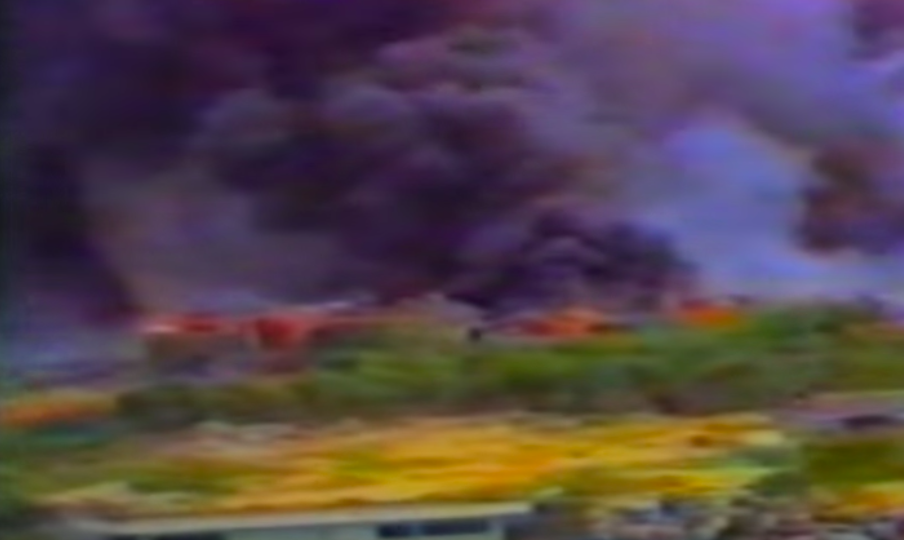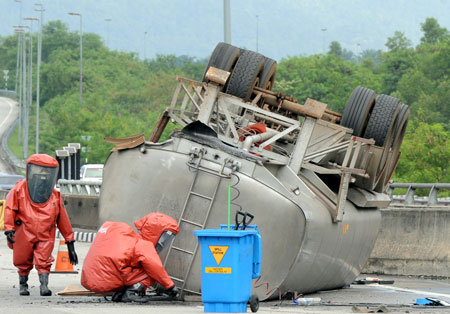The terrifying 1991 incident that turned Sungai Buloh into ‘Hiroshima’

- 1.8KShares
- Facebook1.7K
- Twitter9
- LinkedIn15
- Email12
- WhatsApp74
For most of us, when we hear the name Sungai Buloh, we would often think about the Restoran Jejantas at the rest area, the new MRT station, or even the really huge Sungai Buloh hospital. Other than that, we would just think that Sungai Buloh has houses and nothing else.
But Sungai Buloh has actually seen a past that we never imagined could happen there. You may or may not know that back in 1930, Sungai Buloh was one of the largest and most modern leprosy settlements in the world isolating some Malays, Chinese, Indians as well as some Eurasians and Turks.

But Sungai Buloh was not prepared for what came after that. In 1991, a really huge tragedy happened that claimed many lives and caused really huge destruction.
It was an event so tragic, Sungai Buloh was described as… ‘Hiroshima’
Yes, you read that right. The media specifically called it ‘Hiroshima Sungai Buloh’ because the aftermath of the tragedy made Sungai Buloh look as if she was actually in a war zone.

All of this happened when a factory manager-cum-chemist from Hong Kong, Long Tat Heng, was testing out a firecracker in The Bright Sparklers Factory. Everything went wrong at around 3:45pm on 7 May 1991 when explosive chemicals from his experiment split and started fires that spread to the “Bazookas”, which is the name given for the stored and packaged firecrackers. And you can guess what happened next:
A chain of explosions started happening but it didn’t stop there. 10 minutes later, a second explosion happened and then at 4pm, the third and largest explosion happened that could be felt 4 kilometers away from the factory.
20 more followed after that and the pillar of smoke that rose from the factory could be seen from 8 kilometers away.

The massive amount of explosions didn’t just destroy the factory but also 200 houses nearby. In total, 200 tonnes of brimstone had exploded and the debris from the explosion spread across 7 kilometers. Even the shaking from the explosions could be felt from that far. No wonder the media called it Hiroshima Sungai Buloh.
The whole situation was already so chaotic that traffic jams delayed victims from reaching to the hospitals and even regular citizens started using their own vans and lorries to help the injured victims get there. As for the family members who were already at the hospitals, they were unsure if they could be able to identify their loved ones.

On that day, the bomba did more than put out fires

8 fire trucks were sent to the explosion site and Hamzah Buyok who was from the Shah Alam department described a situation that sounds as if he were really at Hiroshima after the bombing.
“When I was about 10 kilometers from the location, I saw a huge pillar of smoke and felt inside me that something bad was about to happen” – translation from Hamzah Buyok in an interview with TV3’s Detik Tragik.
According to him, the first thing he saw when approaching the location was a dead body laying across the road. It was believed that this victim was trying to save his life but got ran over by an oncoming vehicle. Other corpses were on the road as well that the firemen had to find an alternative route to reach the factory.

“Usually when around this area, the buildings are all there. Now, it’s just like a crater with sand all around” quote by Hamzah Buyok, translated from Detik Tragik.
To make things worse, more than 50 firemen were there to put out the fire but the water pressure was low and the water tap was far away. The fire spread real quickly and there were strong winds as well as a few more fire outbreaks. And when the firemen had actually arrived on site, the fire had already spread to the third nearest house from the factory.

“The firemen and the military force came so we tried to take out the fire. But it seems impossible already. What they did was they used a rock to squeeze the water hose. – quote Mohd Othman Hj. Abd. Karim, a resident from the area, translated from Detik Tragik.
For two hours, the fire department took out the fire using water they brought on their own and they managed to prevent the fire from spreading to other houses nearby. But they still couldn’t carry out their search operations after that because they were worried another explosion could happen. Apparently there were still three more storages with explosives they haven’t found. In fact, two of the storages that exploded before this formed a 6-meter deep hole.
There was also fire coming out of parts of the building at 2:30am so the fire and rescue team had to wait the whole night to monitor the factory site. Thankfully, up till 5am, no further explosions happened.

A day after the explosions, the firemen went on with their search operations and found a lot of corpses in really graphic conditions. Some of them were without limbs or head and some were even half-bodied. 26 of them were found in a rigid condition, including the chemist who tested the firecracker.

In total 83 people were found to be injured and the search operation continued 24 hours every day. But although they found some of the victims, it was still uncertain exactly how many people were missing because the factory workers didn’t get their attendance recorded and those who survived hadn’t reported themselves.
The search continued into day 3 and things started getting more difficult when it started raining at 2:30pm. Chemical reactions started happening with the rain to form poisonous gases. This got so bad that the 200 people from the rescue team were ordered to leave the location to avoid anything worse from happening to them. 50 of those who were there reported having difficulty breathing, swelling and itchiness on their faces, hands and bodies.

The search and rescue operations continued for around more than 11 days, and as investigations were being done…
… more and more was revealed about the factory
The Bright Sparklers have been said to be operating illegally in Malaysia since 1978. But the Malaysian Trade News magazine says that it was only the Menteri Besar of Selangor who considered that Bright Sparklers was illegal. Another source actually says that 8 Federal Ministries and agencies have already given license to approve Bright Sparklers.
But then the question would be, if the factory was illegal, why didn’t the Selangor State government do anything for 17 years?

Now, it isn’t really clear what happened with the owners and directors of the factory. We don’t really know where the directors and owners of the factory went and more interestingly, it was reported that the Registry of Companies claimed that the Police had taken away the files on the Bright Sparklers Sdn. Bhd from them. Hmm… seems really sudden that two days later their name would just disappear from the list.
Lim Kit Siang gave a statement saying that he was concerned this could be a cover up and called for the Royal Commission of Inquiry to not back down questioning whether the Federal and State Selangor Government was negligent.
The whole case only closed after 15 years in 2006 according to the Star. A total of 118 people who got injured and had their property destroyed received a lump sum of RM30, 000 from Chin Kong Hin, the director of the Bright Sparklers. No settlements were made with Chung Kin Chuan, the other directors of the Bright Sparklers or the company itself.

Salimah Che Man, a worker who was only 19-years old, aided the case. During the entire search and rescue operations, although she was still traumatized and receiving treatment, with her help the bomba was able to locate the other stored firecrackers in under 15 minutes.

But here’s the most important thing they found. Although it was the chemist who caused all the entire tragedy, they found out that the place where he tested the fireworks was outside a canteen in the factory premise. Fireworks factories were all ordered to close down after this incident and fireworks were made illegal. Currently, they are still illegal in Malaysia except for two types which are the ‘pop pops’ and ‘happy booms‘.
What did the Bright Sparklers tragedy leave for us?
An awareness for safety.

Without the Bright Sparklers happening, the bomba may not have established the Hazardous Material Unit Team (HAZMAT) that specializes in handling chemicals and radiation. Thanks to their establishment, they have managed to step into a chemical leak that happened at Jalan Tun Kudu, Malacca as well as a oil spill from a crash that happened on the Pan Borneo Highway.
Other than that, the Parliament also passed the Occupational Safety and Health Act 1994 only after the whole tragedy. Given what has happened with the Bright Sparklers this act highlights how crucial it is for employers are responsible in setting up a safe working environment for their employees. This act is helpful especially for construction workers who work in high risk conditions.
- 1.8KShares
- Facebook1.7K
- Twitter9
- LinkedIn15
- Email12
- WhatsApp74



